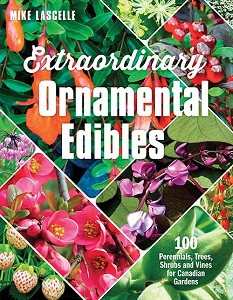Salmonberry – A West Coast Delicacy
Linden – An Ancient Herbal Wonder
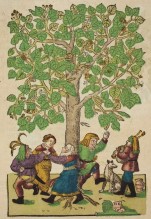 Tilia or Linden trees have long been sacred in Slavic cultures and featured prominently in early German mythology. So much so that many villages had a tree growing in the central square where the community celebrated or discussed important decisions, with the latter specimens often being referred to as Gerichtslinde or ‘Court Linden’. Communal celebrations and dances held under the Lindens were often
Tilia or Linden trees have long been sacred in Slavic cultures and featured prominently in early German mythology. So much so that many villages had a tree growing in the central square where the community celebrated or discussed important decisions, with the latter specimens often being referred to as Gerichtslinde or ‘Court Linden’. Communal celebrations and dances held under the Lindens were often 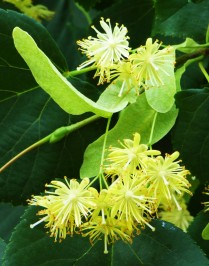 linked to superstitions involving fertility, improving one’s luck and finding true love. Whatever the past beliefs associated with this tree, the modern species has a lot to offer and is often found in our urban forests. Perhaps the most common of these is Tilia cordata or Littleleaf Linden, although the Large-Leaved Lime (Tilia platyphyllos) and American Basswood (Tilia americana) are also quite easy to find. All three species have highly fragrant
linked to superstitions involving fertility, improving one’s luck and finding true love. Whatever the past beliefs associated with this tree, the modern species has a lot to offer and is often found in our urban forests. Perhaps the most common of these is Tilia cordata or Littleleaf Linden, although the Large-Leaved Lime (Tilia platyphyllos) and American Basswood (Tilia americana) are also quite easy to find. All three species have highly fragrant  edible flowers and young leaves, although the latter are quite bland and best added to a mixed dressed salad. The white bloom clusters emerge in early summer, at which time their heady fragrance pervades the air. As these are common street trees, many urban foragers take advantage of these flowers which can be made into a refreshing hot or iced tea, and an amazing cordial. I discovered the latter from a German gardener, Wolfgang, who told me in no
edible flowers and young leaves, although the latter are quite bland and best added to a mixed dressed salad. The white bloom clusters emerge in early summer, at which time their heady fragrance pervades the air. As these are common street trees, many urban foragers take advantage of these flowers which can be made into a refreshing hot or iced tea, and an amazing cordial. I discovered the latter from a German gardener, Wolfgang, who told me in no 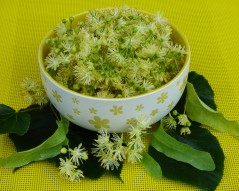 uncertain terms that Linden flowers made a much tastier cordial than the elderflowers (Sambucus nigra) that I was asking him about. Luckily I found a row of Linden street trees on my morning cycling route and just had to wait until I could smell them to know when they were ready to harvest. When foraging linden flowers it is important to harvest young bloom clusters, with only a few open flowers,
uncertain terms that Linden flowers made a much tastier cordial than the elderflowers (Sambucus nigra) that I was asking him about. Luckily I found a row of Linden street trees on my morning cycling route and just had to wait until I could smell them to know when they were ready to harvest. When foraging linden flowers it is important to harvest young bloom clusters, with only a few open flowers,  as faded blooms can induce a narcotic intoxication in some people. The other word of warning here is that if you are allergic to Linden pollen, then chances are you will react badly to ingesting the teas, cordials or young foliage. Which would be a shame, because few things are so tantalizing to the palate as an iced glass of Linden cordial mixed with a little sparkling wine or
as faded blooms can induce a narcotic intoxication in some people. The other word of warning here is that if you are allergic to Linden pollen, then chances are you will react badly to ingesting the teas, cordials or young foliage. Which would be a shame, because few things are so tantalizing to the palate as an iced glass of Linden cordial mixed with a little sparkling wine or 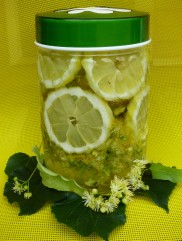 carbonated water. The recipe for the base is rather easy; just add 2 unpacked cups of cleaned (bracts removed but not washed) linden flowers and one medium lemon (rind zested and sliced) for every 1L or 32oz mason jar, fill with a
carbonated water. The recipe for the base is rather easy; just add 2 unpacked cups of cleaned (bracts removed but not washed) linden flowers and one medium lemon (rind zested and sliced) for every 1L or 32oz mason jar, fill with a 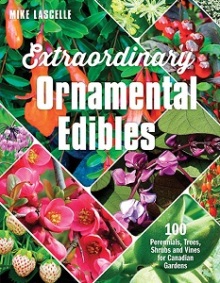 simple premade white sugar / water syrup and refrigerate for 2 days. This will infuse the flavour of the Linden blooms into the syrup, after which you strain the contents through cheesecloth, with the base syrup lasting for about a month in the fridge. The tea is just as easy to prepare and can be made from fresh or dried blossoms, just use about 1-2 teaspoons of Linden flowers for every cup. Linden tea is high in flavonoids which act as antioxidants and is considered an aid to digestion and a calming beverage. You can find more unusual edible plants to grow in your garden between the pages of my new book, Extraordinary Ornamental Edibles, available from Douglas & McIntyre.
simple premade white sugar / water syrup and refrigerate for 2 days. This will infuse the flavour of the Linden blooms into the syrup, after which you strain the contents through cheesecloth, with the base syrup lasting for about a month in the fridge. The tea is just as easy to prepare and can be made from fresh or dried blossoms, just use about 1-2 teaspoons of Linden flowers for every cup. Linden tea is high in flavonoids which act as antioxidants and is considered an aid to digestion and a calming beverage. You can find more unusual edible plants to grow in your garden between the pages of my new book, Extraordinary Ornamental Edibles, available from Douglas & McIntyre.
Harvesting Wasabi
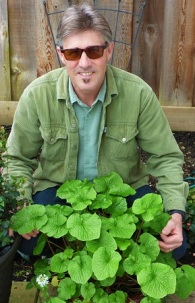 I garden in a townhouse with a large patio, so almost all my edibles are grown in containers. Among them are two apples (‘Golden & Scarlet Sentinel’), a fig tree (‘Little Ruby’), a genetic dwarf nectarine (‘Golden Prolific’), one of the Romance Series cherries (‘Romeo’), strawberry guava (Ugni molinae), green tea (Camellia sinensis ‘Korean
I garden in a townhouse with a large patio, so almost all my edibles are grown in containers. Among them are two apples (‘Golden & Scarlet Sentinel’), a fig tree (‘Little Ruby’), a genetic dwarf nectarine (‘Golden Prolific’), one of the Romance Series cherries (‘Romeo’), strawberry guava (Ugni molinae), green tea (Camellia sinensis ‘Korean 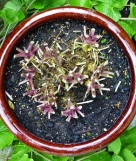 Seedling’), Vaccinium ‘Blueberry Glaze’, ‘Barbeque’ rosemary, ‘Silver Posie’ English thyme, variegated marjoram, golden wild strawberries (Fragaria vesca ‘Golden Alexandria’) and wasabi. The latter is grown in a shady northeast corner of my patio in a medium-sized 14″ wide pot that is about 8″ deep. I started with a one gallon
Seedling’), Vaccinium ‘Blueberry Glaze’, ‘Barbeque’ rosemary, ‘Silver Posie’ English thyme, variegated marjoram, golden wild strawberries (Fragaria vesca ‘Golden Alexandria’) and wasabi. The latter is grown in a shady northeast corner of my patio in a medium-sized 14″ wide pot that is about 8″ deep. I started with a one gallon 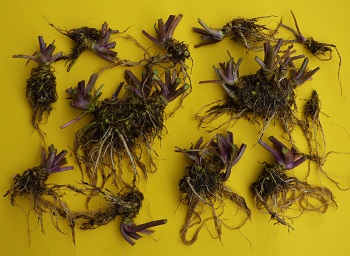 plant that was selected from a cold hardy strain found naturalized at the north end of Pitt Lake. This proved to be essential for me as mine survived the record breaking cold temperatures of the winter of 2016/2017, when Vancouver averaged -5C for over 32 days – while this did kill the top foliage (which is usually evergreen through winter), it sprouted back with a vengeance the following spring. When you consider that Wasabia japonica (syn. Eutrema
plant that was selected from a cold hardy strain found naturalized at the north end of Pitt Lake. This proved to be essential for me as mine survived the record breaking cold temperatures of the winter of 2016/2017, when Vancouver averaged -5C for over 32 days – while this did kill the top foliage (which is usually evergreen through winter), it sprouted back with a vengeance the following spring. When you consider that Wasabia japonica (syn. Eutrema 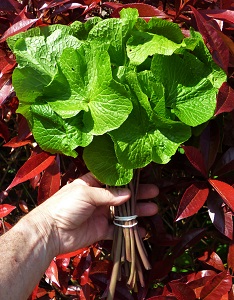 japonicum) is only hardy to USDA zone 7, that was an excellent outcome. My plan was to grow it for two years before harvesting, so that put me on track to enjoy my first harvest in spring 2018. I used an organic Sea Soil container mix and limited my fertilizer to a slow release 14-14-14 and some of Gaia Green’s glacial rock dust. Watering must be consistent as this species requires constant moisture
japonicum) is only hardy to USDA zone 7, that was an excellent outcome. My plan was to grow it for two years before harvesting, so that put me on track to enjoy my first harvest in spring 2018. I used an organic Sea Soil container mix and limited my fertilizer to a slow release 14-14-14 and some of Gaia Green’s glacial rock dust. Watering must be consistent as this species requires constant moisture 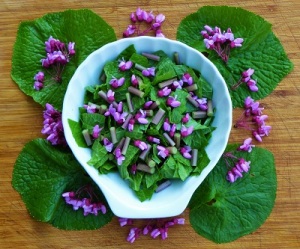 and the only pests I encountered were slugs, which the container helped to keep at bay. While there were about a dozen offsets harvested, I was a little disappointed that the roots weren’t longer, but I noticed that the soil near the bottom of the pot was quite compacted – so I replanted three offsets using a looser Black Gold organic blend. I didn’t want to waste the foliage and stems that were cut off
and the only pests I encountered were slugs, which the container helped to keep at bay. While there were about a dozen offsets harvested, I was a little disappointed that the roots weren’t longer, but I noticed that the soil near the bottom of the pot was quite compacted – so I replanted three offsets using a looser Black Gold organic blend. I didn’t want to waste the foliage and stems that were cut off  during harvest (both are edible), so I made a simple foraged salad of chopped leaves and stems with some Redbud flowers (Cercis canadensis), an ornamental tree planted in my townhouse complex – with a little red pepper dressing it turned out to be delicious. You can also cook
during harvest (both are edible), so I made a simple foraged salad of chopped leaves and stems with some Redbud flowers (Cercis canadensis), an ornamental tree planted in my townhouse complex – with a little red pepper dressing it turned out to be delicious. You can also cook 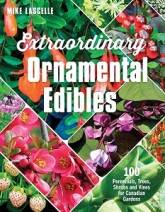 wasabi leaves tempura-style and serve them with a sweetened soy dip. The rest of the offsets were put in the refrigerator vegetable crisper (where they will last about a month if kept moist), waiting to be shared with my fellow gardeners or grated and enjoyed with some fresh sushi. If you would like to discover more about growing rare edibles in small spaces, look for my new book Extraordinary Ornamental Edibles from Douglas & McIntyre.
wasabi leaves tempura-style and serve them with a sweetened soy dip. The rest of the offsets were put in the refrigerator vegetable crisper (where they will last about a month if kept moist), waiting to be shared with my fellow gardeners or grated and enjoyed with some fresh sushi. If you would like to discover more about growing rare edibles in small spaces, look for my new book Extraordinary Ornamental Edibles from Douglas & McIntyre.
Making Your Own Green Tea
Start With the Right Species – Both green and black teas are made from one species, Camellia sinensis, which has both small (var. sinensis) and large leaf (var. assamica) forms. Black tea is fermented while green teas are not, but both 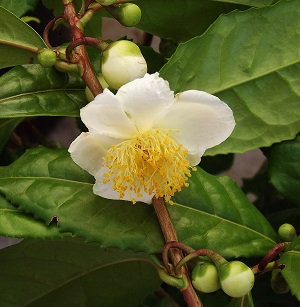 require some amount of processing to bring out their unique flavours. Here in Canada, you are only going to find hardier small-leaved cultivars such as ‘Sochi Seedling’, ‘Teabreeze’, ‘Blushing Maiden’ and ‘Korean Tea Seedling’ – with all of these being hardy to USDA zone 7. They bloom in the fall with small white or pink blossoms (‘Blushing Maiden’) contrasted by golden stamens. I
require some amount of processing to bring out their unique flavours. Here in Canada, you are only going to find hardier small-leaved cultivars such as ‘Sochi Seedling’, ‘Teabreeze’, ‘Blushing Maiden’ and ‘Korean Tea Seedling’ – with all of these being hardy to USDA zone 7. They bloom in the fall with small white or pink blossoms (‘Blushing Maiden’) contrasted by golden stamens. I 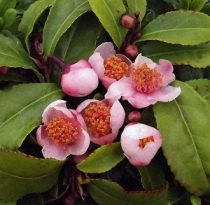 grow my ‘Korean Tea Seedling’ in a large container which is covered by a custom insulating sleeve when the temperature drops below freezing for any length of time. They are broadleaf evergreen shrubs which prefer part to full sun with even soil moisture and acidic soil conditions. Now I am going to walk you through one of the many simple methods to make your own green tea.
grow my ‘Korean Tea Seedling’ in a large container which is covered by a custom insulating sleeve when the temperature drops below freezing for any length of time. They are broadleaf evergreen shrubs which prefer part to full sun with even soil moisture and acidic soil conditions. Now I am going to walk you through one of the many simple methods to make your own green tea.
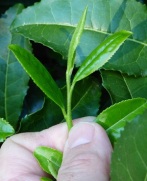 Step 1 / When and What to Pick – Tea leaves are traditionally harvested during spring flush, although new foliage can also be harvested in early summer and fall with those growth periods. Purists will only pick the top two leaves and bud, although you have the option of also harvesting the tender leaves just below these to increase your yield.
Step 1 / When and What to Pick – Tea leaves are traditionally harvested during spring flush, although new foliage can also be harvested in early summer and fall with those growth periods. Purists will only pick the top two leaves and bud, although you have the option of also harvesting the tender leaves just below these to increase your yield.
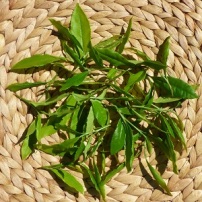 Step 2 / Allow Your Leaves to Dry Naturally – Spread the leaves and buds that you have harvested over a clean drying mat, arranging them in a single layer. This should be placed in the shade for 2-3 hours to allow the leaves to wilt naturally. This step reduces the overall water content, increasing the flavour and making processing easier.
Step 2 / Allow Your Leaves to Dry Naturally – Spread the leaves and buds that you have harvested over a clean drying mat, arranging them in a single layer. This should be placed in the shade for 2-3 hours to allow the leaves to wilt naturally. This step reduces the overall water content, increasing the flavour and making processing easier.
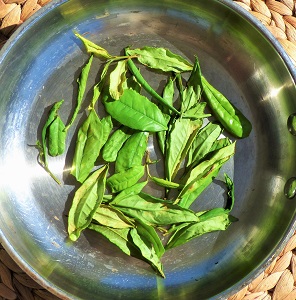 Step 3 / A Mild Heat Treatment – This process is also known as ‘shaqing’ and can be done in the home by placing the previously wilted leaves in a wok or fry pan over a low heat. You are essentially dry roasting them to enrich the flavour (removing some of the grassy taste) and prevent any further oxidization, which can also diminish the quality of the tea. This can be difficult to master as you only want to remove 30-40% of the remaining moisture without getting the leaves crispy. So I suggest you do small batches, stirring the leaves constantly.
Step 3 / A Mild Heat Treatment – This process is also known as ‘shaqing’ and can be done in the home by placing the previously wilted leaves in a wok or fry pan over a low heat. You are essentially dry roasting them to enrich the flavour (removing some of the grassy taste) and prevent any further oxidization, which can also diminish the quality of the tea. This can be difficult to master as you only want to remove 30-40% of the remaining moisture without getting the leaves crispy. So I suggest you do small batches, stirring the leaves constantly.
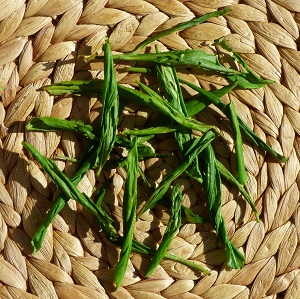 Step 4 / Hand Rolling – The heating or shaqing process also make the hand rolling much easier to do. They can be rolled when hot or cold, although when rolled cold the green colour is retained much better. The simplest method is to just roll these between the palms of your hands into an elongated cigar shape. Rolling the leaves helps to break down the structure, making them better for brewing. Rolled leaves can be brewed fresh or can be preserved for future use by drying in an oven on a baking sheet at 120C for twenty minutes, after which they are cooled. Then simply store in an airtight jar out of bright sunlight.
Step 4 / Hand Rolling – The heating or shaqing process also make the hand rolling much easier to do. They can be rolled when hot or cold, although when rolled cold the green colour is retained much better. The simplest method is to just roll these between the palms of your hands into an elongated cigar shape. Rolling the leaves helps to break down the structure, making them better for brewing. Rolled leaves can be brewed fresh or can be preserved for future use by drying in an oven on a baking sheet at 120C for twenty minutes, after which they are cooled. Then simply store in an airtight jar out of bright sunlight.
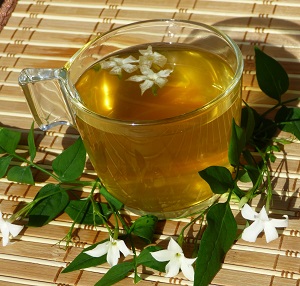 Step 5 / Brewing – Your homemade green tea may not be as strong as those you buy from the store, so you might have to use a bit more than you usually do. That said, be sure to sample it from time to time while it is steeping as the flavour and colours are constantly changing, and you don’t want to miss out on that perfect cup. You can also add a few Jasmine flowers to make your own Jasmine Tea, just be sure to use the right species which is Jasminum officinale.
Step 5 / Brewing – Your homemade green tea may not be as strong as those you buy from the store, so you might have to use a bit more than you usually do. That said, be sure to sample it from time to time while it is steeping as the flavour and colours are constantly changing, and you don’t want to miss out on that perfect cup. You can also add a few Jasmine flowers to make your own Jasmine Tea, just be sure to use the right species which is Jasminum officinale.
The Often Overlooked Osoberry
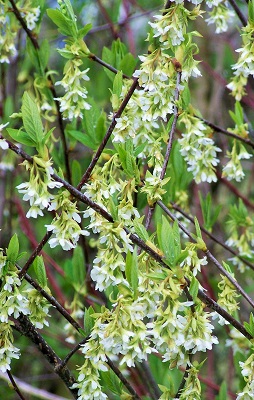 This large deciduous shrub is native from southern British Columbia down to California and is often found on the forest’s edge. It is one of the first wild plants in bloom and as such is an important source of early nectar for the overwintering Anna’s hummingbirds. The small bell-shaped greenish-white flowers are held in
This large deciduous shrub is native from southern British Columbia down to California and is often found on the forest’s edge. It is one of the first wild plants in bloom and as such is an important source of early nectar for the overwintering Anna’s hummingbirds. The small bell-shaped greenish-white flowers are held in 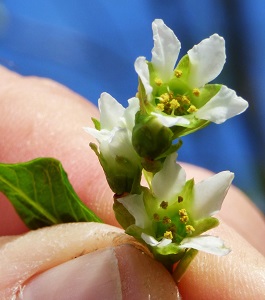 pendulous clusters and this species is dioecious, meaning there are separate male and female plants. Unfortunately, these are rarely sexed at the nursery or garden centres where they are sold, so you will have to
pendulous clusters and this species is dioecious, meaning there are separate male and female plants. Unfortunately, these are rarely sexed at the nursery or garden centres where they are sold, so you will have to 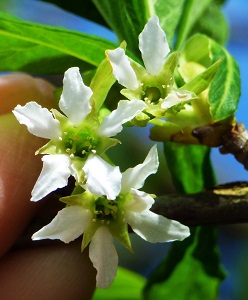 wait until they flower to know which you have purchased. The males are said to have a slight cat urine smell to the flowers, although I have never noticed this even at close
wait until they flower to know which you have purchased. The males are said to have a slight cat urine smell to the flowers, although I have never noticed this even at close  range. The leaves emerge just after the flowers open and have a nice cucumber scent when lightly bruised. The fruit develops soon afterwards, changing from pale yellow, to a peachy-salmon and finally a a dark purplish-blue. These were
range. The leaves emerge just after the flowers open and have a nice cucumber scent when lightly bruised. The fruit develops soon afterwards, changing from pale yellow, to a peachy-salmon and finally a a dark purplish-blue. These were 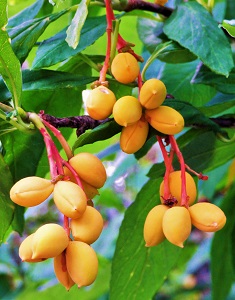 traditionally eaten by indigenous peoples, although the small plum-like berries are quite astringent (tasting of bitter almond) until they soften, at which time they have a strong black cherry flavour, with hints of melon. These have a large pit and are probably best used to enhance other dishes (salad
traditionally eaten by indigenous peoples, although the small plum-like berries are quite astringent (tasting of bitter almond) until they soften, at which time they have a strong black cherry flavour, with hints of melon. These have a large pit and are probably best used to enhance other dishes (salad 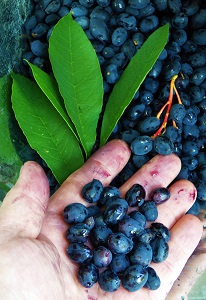 dressings or summer drinks in the form of a syrup) or preserves, such as the wild blueberry (Vaccinium angustifolium) jelly I made with about 10% Osoberry – any more overpowers the sweet flavour. The other common names include Oregon Plum or Indian Plum, with the latter no longer considered politically correct. It is known botanically as both Oemleria cerasiformis or Osmaronia cerasiformis, and grows 9-
dressings or summer drinks in the form of a syrup) or preserves, such as the wild blueberry (Vaccinium angustifolium) jelly I made with about 10% Osoberry – any more overpowers the sweet flavour. The other common names include Oregon Plum or Indian Plum, with the latter no longer considered politically correct. It is known botanically as both Oemleria cerasiformis or Osmaronia cerasiformis, and grows 9-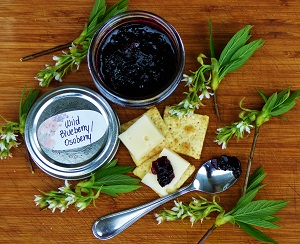 12′ tall on average, preferring an open shade to sun exposure with even soil moisture – being hardy to USDA zone 6. Because the fruit does contain natural hydrogen cyanide, it is best to limit your intake to small quantities…that said, a perfectly ripened Osoberry is one of nature’s most delicious treats.
12′ tall on average, preferring an open shade to sun exposure with even soil moisture – being hardy to USDA zone 6. Because the fruit does contain natural hydrogen cyanide, it is best to limit your intake to small quantities…that said, a perfectly ripened Osoberry is one of nature’s most delicious treats.
Cooking with Lavender – A Taste of Provence
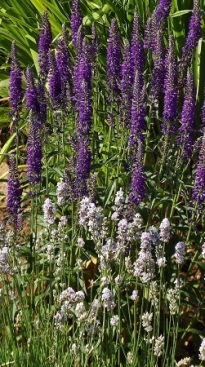 The first thing you need to know about Lavender is that it is more of a spice than a food ingredient. And by spice, I mean a strong tasting one, so a little restraint is the best way to approach this plant in regards to cooking. We should begin by understanding which species are best for culinary use and fortunately, both are readily available. English lavender (Lavandula angustifolia) and Lavandin or Provence lavender (Lavandula x intermedia) are the two species most commonly used for cooking, while the ones to avoid are Spanish lavender (Lavandula stoechas) and French lavender (Lavandula dentata) – as both of these have a high
The first thing you need to know about Lavender is that it is more of a spice than a food ingredient. And by spice, I mean a strong tasting one, so a little restraint is the best way to approach this plant in regards to cooking. We should begin by understanding which species are best for culinary use and fortunately, both are readily available. English lavender (Lavandula angustifolia) and Lavandin or Provence lavender (Lavandula x intermedia) are the two species most commonly used for cooking, while the ones to avoid are Spanish lavender (Lavandula stoechas) and French lavender (Lavandula dentata) – as both of these have a high 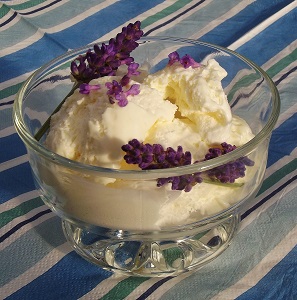 camphor content which would ruin the flavour of any recipe. You are essentially using the buds to cook with, so harvest entire stems just as the flowers begin to open (after the dew has dried), as this is the time when the essential oils are at their peak and the colour is more easily retained. Bundle your stems with an elastic band and hang upside down in an
camphor content which would ruin the flavour of any recipe. You are essentially using the buds to cook with, so harvest entire stems just as the flowers begin to open (after the dew has dried), as this is the time when the essential oils are at their peak and the colour is more easily retained. Bundle your stems with an elastic band and hang upside down in an 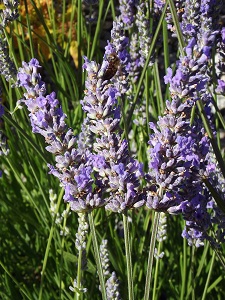 indoor space that is out of sunlight, but with good air circulation and warmth. Your bunches of lavender should be dry in a few weeks, after which you can either strip the buds from the individual stems by hand or simply roll the bundle in your palms, allowing the buds to drop into a container below. The buds can then be stored in an airtight jar
indoor space that is out of sunlight, but with good air circulation and warmth. Your bunches of lavender should be dry in a few weeks, after which you can either strip the buds from the individual stems by hand or simply roll the bundle in your palms, allowing the buds to drop into a container below. The buds can then be stored in an airtight jar 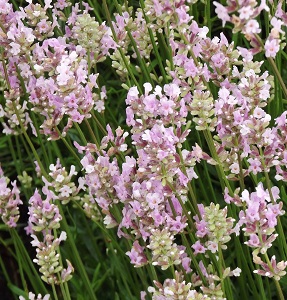 for up to 6 months for cooking purposes, longer for crafting. I have three daughters – Nicole, Rochelle and Madeleine – all of whom cook with lavender. My youngest, Madeleine, makes mouth-watering Lavender Earl Grey shortbread cookies and the recipe can be found on the Stash Tea site at http://www.stashtea.com under the tea recipes blog. A mayonnaise or lavender aioli is another of
for up to 6 months for cooking purposes, longer for crafting. I have three daughters – Nicole, Rochelle and Madeleine – all of whom cook with lavender. My youngest, Madeleine, makes mouth-watering Lavender Earl Grey shortbread cookies and the recipe can be found on the Stash Tea site at http://www.stashtea.com under the tea recipes blog. A mayonnaise or lavender aioli is another of 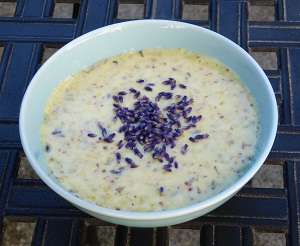 my favourites, and is often served on barbecue night at my other daughter’s house, making that lamb chop taste like a million dollars. A simple use for lavender is to just lightly sprinkle it over some good quality vanilla ice cream and gently mix it in, as the two flavours really do compliment each other. Lavender is also one of the key ingredients in the Herbes de Provence, which also includes marjoram, rosemary, thyme and savory, although there are many
my favourites, and is often served on barbecue night at my other daughter’s house, making that lamb chop taste like a million dollars. A simple use for lavender is to just lightly sprinkle it over some good quality vanilla ice cream and gently mix it in, as the two flavours really do compliment each other. Lavender is also one of the key ingredients in the Herbes de Provence, which also includes marjoram, rosemary, thyme and savory, although there are many 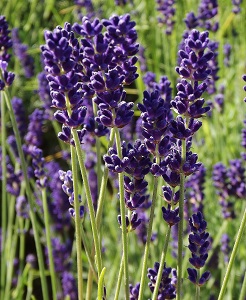 variations of this with other herbs. Regardless of use, you need to be sure that your culinary lavender is harvested from plants free of pesticides, which will mean that you will have to grow out new plants for a year before harvesting. That said, English lavender makes a great addition to any sunny, well-drained garden with the best cultivars being ‘Hidcote’, ‘Munstead’, ‘Jean Davis’ (pink) and ‘Alba’ (white). For Lavandin, you are only likely to find either ‘Provence’ or ‘Grosso’, and expect much taller mature plants at around 3-4′. Regardless of which lavenders choose, I guarantee you that they will taste as good as they smell.
variations of this with other herbs. Regardless of use, you need to be sure that your culinary lavender is harvested from plants free of pesticides, which will mean that you will have to grow out new plants for a year before harvesting. That said, English lavender makes a great addition to any sunny, well-drained garden with the best cultivars being ‘Hidcote’, ‘Munstead’, ‘Jean Davis’ (pink) and ‘Alba’ (white). For Lavandin, you are only likely to find either ‘Provence’ or ‘Grosso’, and expect much taller mature plants at around 3-4′. Regardless of which lavenders choose, I guarantee you that they will taste as good as they smell.
The Versatile Edible Elderberry
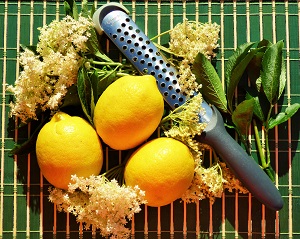 Few shrubs have been cultivated or harvested as long as the Black Elderberry (Sambucus nigra) – in fact, there is some evidence that is was utilized by prehistoric man in Italy and Switzerland – so its use may even predate our species. That said, it was an important medicinal and food crop for
Few shrubs have been cultivated or harvested as long as the Black Elderberry (Sambucus nigra) – in fact, there is some evidence that is was utilized by prehistoric man in Italy and Switzerland – so its use may even predate our species. That said, it was an important medicinal and food crop for 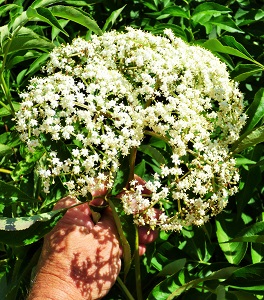 many ancient civilizations, including Egyptian, Greek and Roman. The common name is derived from the Anglo-Saxon word ‘aeld’ or ‘fire’, which is a reference to the use of the hollowed-out stems as billows for fires or pipes. The health benefits are many, as the berries are high in vitamins A and C (more than any other plant besides black currant and rose
many ancient civilizations, including Egyptian, Greek and Roman. The common name is derived from the Anglo-Saxon word ‘aeld’ or ‘fire’, which is a reference to the use of the hollowed-out stems as billows for fires or pipes. The health benefits are many, as the berries are high in vitamins A and C (more than any other plant besides black currant and rose 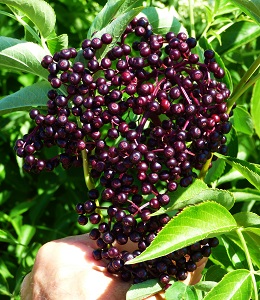 hips), and antioxidants, as well as its ability to reduce cholesterol and inflammation. There is also a similar North American species with black fruit called Sambucus canadensis (sometimes listed as Sambucus nigra var. canadensis) which is a bit hardier at USDA zone 3. As for the other common Elderberries we find here which have been traditionally eaten by indigenous peoples, I
hips), and antioxidants, as well as its ability to reduce cholesterol and inflammation. There is also a similar North American species with black fruit called Sambucus canadensis (sometimes listed as Sambucus nigra var. canadensis) which is a bit hardier at USDA zone 3. As for the other common Elderberries we find here which have been traditionally eaten by indigenous peoples, I 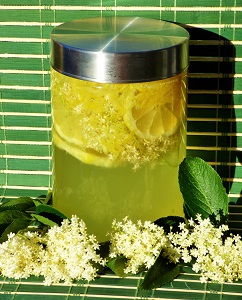 think both the red (Sambucus racemosa) and the blue (Sambucus caerulea) should be treated strictly as ornamentals. While I was well aware of the traditional use of black elderberries to make delicious jellies and wines, I stumbled upon the recipe for the flower cordial while researching my new book, Extraordinary Ornamental Edibles – 100 Perennials, Trees, Shrubs and Vines for Canadian Gardens. I can only describe the result as ‘spring in
think both the red (Sambucus racemosa) and the blue (Sambucus caerulea) should be treated strictly as ornamentals. While I was well aware of the traditional use of black elderberries to make delicious jellies and wines, I stumbled upon the recipe for the flower cordial while researching my new book, Extraordinary Ornamental Edibles – 100 Perennials, Trees, Shrubs and Vines for Canadian Gardens. I can only describe the result as ‘spring in 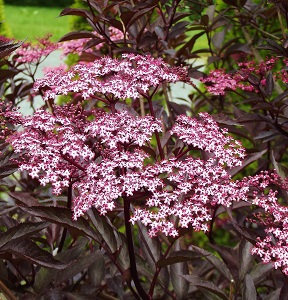 a glass’, as this refreshing cordial makes me want to sacrifice all the berries for the flowers. The recipe is simple; just boil 6 cups of water and 5 cups of sugar to make a syrup base and pour this into mason jars. After cooling add 15 large elderflower blossoms (shaken clean not washed, as the latter will dampen the flavour) and four lemons, zested and sliced. Store in your refrigerator for 2 days and strain through cheesecloth. This cordial base can be added to sparkling water or Prosecco for a fabulous summer cocktail, best served on ice. The other benefit here is that there
a glass’, as this refreshing cordial makes me want to sacrifice all the berries for the flowers. The recipe is simple; just boil 6 cups of water and 5 cups of sugar to make a syrup base and pour this into mason jars. After cooling add 15 large elderflower blossoms (shaken clean not washed, as the latter will dampen the flavour) and four lemons, zested and sliced. Store in your refrigerator for 2 days and strain through cheesecloth. This cordial base can be added to sparkling water or Prosecco for a fabulous summer cocktail, best served on ice. The other benefit here is that there 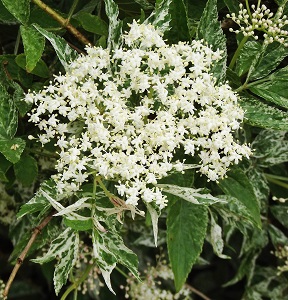 are many ornamental forms of Sambucus nigra with edible berries including the black-leaved ‘Eva’ (or BLACK LACE), the variegated ‘Pulverulenta’ and the cut-leaf form laciniata. ‘Korsor’ a Danish cultivar is your best bet for fruit production, while Sambucus canadensis ‘York’ and ‘Nova’ are good North American producers. Sambucus nigra is hardy to USDA zone 4 and partially self-fertile, while Sambucus canadensis does require cross-pollination for fruit production. Both are large shrubs averaging 8-10′ high and wide, preferring evenly moist (but not wet) soils with a part to full sun exposure. So if you are looking for an edible ornamental shrub that has it all, look no further than Black Elderberry!
are many ornamental forms of Sambucus nigra with edible berries including the black-leaved ‘Eva’ (or BLACK LACE), the variegated ‘Pulverulenta’ and the cut-leaf form laciniata. ‘Korsor’ a Danish cultivar is your best bet for fruit production, while Sambucus canadensis ‘York’ and ‘Nova’ are good North American producers. Sambucus nigra is hardy to USDA zone 4 and partially self-fertile, while Sambucus canadensis does require cross-pollination for fruit production. Both are large shrubs averaging 8-10′ high and wide, preferring evenly moist (but not wet) soils with a part to full sun exposure. So if you are looking for an edible ornamental shrub that has it all, look no further than Black Elderberry!
Redbud…the Dessert and Vegetable Tree
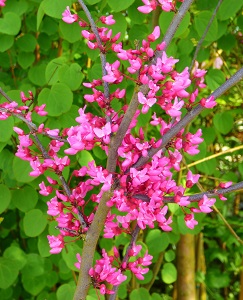 It might surprise you to know how many duo-purpose plants you already have growing in your garden – those that taste as good as they look. One of these unsung heroes is the Eastern Redbud or Cercis canadensis. Most gardeners think of these small trees as exciting foliage plants or flowering specimens, with their brilliant magenta-pink blooms encrusting the branches just before the leaves emerge. But these natives of Eastern North
It might surprise you to know how many duo-purpose plants you already have growing in your garden – those that taste as good as they look. One of these unsung heroes is the Eastern Redbud or Cercis canadensis. Most gardeners think of these small trees as exciting foliage plants or flowering specimens, with their brilliant magenta-pink blooms encrusting the branches just before the leaves emerge. But these natives of Eastern North 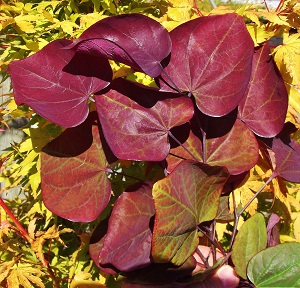 America have a long history of food culture among indigenous peoples who ate the flowers, seedpods and roasted seeds. Interest in this species as an ornamental hit high gear about 25 years ago with the introduction of ‘Forest Pansy’, with leaves that emerge a brilliant glossy reddish-purple. This was soon followed by a myriad of foliage options including marbled white (‘Floating Clouds’), peachy-orange (THE RISING SUN) and golden-yellow (‘Hearts of Gold’). Adding to this species’ interest were the many tree forms available that vary from dwarf (‘Little Woody’), weeping
America have a long history of food culture among indigenous peoples who ate the flowers, seedpods and roasted seeds. Interest in this species as an ornamental hit high gear about 25 years ago with the introduction of ‘Forest Pansy’, with leaves that emerge a brilliant glossy reddish-purple. This was soon followed by a myriad of foliage options including marbled white (‘Floating Clouds’), peachy-orange (THE RISING SUN) and golden-yellow (‘Hearts of Gold’). Adding to this species’ interest were the many tree forms available that vary from dwarf (‘Little Woody’), weeping 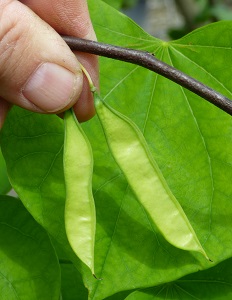 (‘Ruby Falls’) and even zigzag branching (‘Covey’). Redbud blooms in early spring before the leaves emerge and mature trees are encrusted with a multitude of tiny pea-like flowers which are generally an eye-catching magenta-pink for the species. But with a little diligence one can find some variation in bloom colour with cultivars such as ‘Alba’ (white), ‘Pauline Lily’ (salmon), ‘Appalachian Red’ (magenta-red) or the aforementioned ‘Hearts of
(‘Ruby Falls’) and even zigzag branching (‘Covey’). Redbud blooms in early spring before the leaves emerge and mature trees are encrusted with a multitude of tiny pea-like flowers which are generally an eye-catching magenta-pink for the species. But with a little diligence one can find some variation in bloom colour with cultivars such as ‘Alba’ (white), ‘Pauline Lily’ (salmon), ‘Appalachian Red’ (magenta-red) or the aforementioned ‘Hearts of 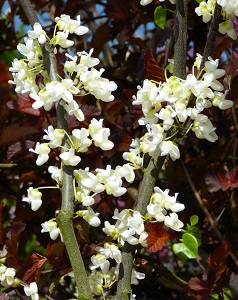 Gold’, which has lavender flowers. These edible beauties are the dessert portion of this tree, as they have a sweet nutty flavour reminiscent of young English peas with honey. They are also visually spectacular when added to salads or used as a garnish, but my preference is to bake them in homemade fritters or muffins. Young unopened flowers can also be pickled and used as a caper substitute. The vegetable component of Redbud are the young seedpods that develop soon after, which look and taste just like snow peas – these are best
Gold’, which has lavender flowers. These edible beauties are the dessert portion of this tree, as they have a sweet nutty flavour reminiscent of young English peas with honey. They are also visually spectacular when added to salads or used as a garnish, but my preference is to bake them in homemade fritters or muffins. Young unopened flowers can also be pickled and used as a caper substitute. The vegetable component of Redbud are the young seedpods that develop soon after, which look and taste just like snow peas – these are best 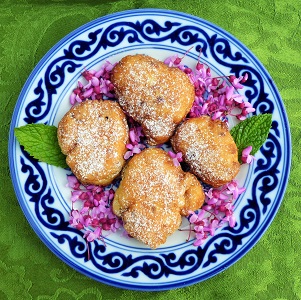 eaten in moderation with a little butter. Mature pods become too astringent to be palatable, so make sure you pick them young for cooking. Personally I don’t recommend eating the mature seeds or making herbal teas from the astringent inner bark (used for fevers or diarrhea), as was traditionally practiced by first nations, as the Redbud does contain some toxic
eaten in moderation with a little butter. Mature pods become too astringent to be palatable, so make sure you pick them young for cooking. Personally I don’t recommend eating the mature seeds or making herbal teas from the astringent inner bark (used for fevers or diarrhea), as was traditionally practiced by first nations, as the Redbud does contain some toxic 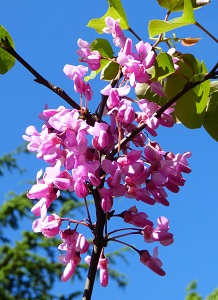 saponins. In regards to its cultural requirements, Redbud prefers well-drained soils with a partial shade exposure (particularly gold-leaved forms) in areas with hot summers. They are USDA zone 6 hardy and average 18-30′ tall at maturity, growing fairly slow when young. Of equal interest for its edible flowers and young cooked seedpods is the European version of this species, Cercis siliquastrum, which is also known as the Judas Tree.
saponins. In regards to its cultural requirements, Redbud prefers well-drained soils with a partial shade exposure (particularly gold-leaved forms) in areas with hot summers. They are USDA zone 6 hardy and average 18-30′ tall at maturity, growing fairly slow when young. Of equal interest for its edible flowers and young cooked seedpods is the European version of this species, Cercis siliquastrum, which is also known as the Judas Tree.
Oregon Grape…Beauty and the Feast
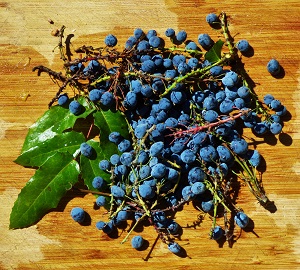 I have been gardening professionally for close to four decades and as I get older it seems that plants should have a higher function than strictly ornamental, which is why edibles have been my focus of late. Growing your own food connects us with nature and it is my hope that this burgeoning relationship will help us all treat the planet we share with a little more
I have been gardening professionally for close to four decades and as I get older it seems that plants should have a higher function than strictly ornamental, which is why edibles have been my focus of late. Growing your own food connects us with nature and it is my hope that this burgeoning relationship will help us all treat the planet we share with a little more 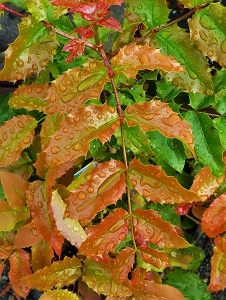 respect and nurture. Of course, I have no problem with duo-purpose plants – those that are as beautiful as they are flavourful – as these are the inspiration for my new book, Extraordinary Ornamental Edibles – 100 Perennials, Trees, Shrubs and Vines for Canadian Gardens. Of the many plants featured in this tome, none exceeds the versatility of the Oregon Grape. Unfortunately this is a common
respect and nurture. Of course, I have no problem with duo-purpose plants – those that are as beautiful as they are flavourful – as these are the inspiration for my new book, Extraordinary Ornamental Edibles – 100 Perennials, Trees, Shrubs and Vines for Canadian Gardens. Of the many plants featured in this tome, none exceeds the versatility of the Oregon Grape. Unfortunately this is a common 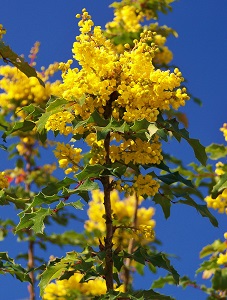 name applied to several species – Mahonia aquifolium, Mahonia nervosa and Mahonia repens – all of which are native to the Pacific Northwest region of North America. The most common of these, Mahonia aquifolium or Tall Oregon Grape is a common landscape feature due to its versatility and multiple seasons of colour. It begins the year with a flush of brassy-coloured holly-like foliage and blooms shortly afterwards, in early spring. The bright yellow terminal flower clusters are highly sought after by the Rufous and Anna’s hummingbirds, providing much needed nectar after the meager winter foraging. The foliage shifts to a lustrous deep green which is only lightly prickly, but burly enough at maturity to make it a useful hedge against
name applied to several species – Mahonia aquifolium, Mahonia nervosa and Mahonia repens – all of which are native to the Pacific Northwest region of North America. The most common of these, Mahonia aquifolium or Tall Oregon Grape is a common landscape feature due to its versatility and multiple seasons of colour. It begins the year with a flush of brassy-coloured holly-like foliage and blooms shortly afterwards, in early spring. The bright yellow terminal flower clusters are highly sought after by the Rufous and Anna’s hummingbirds, providing much needed nectar after the meager winter foraging. The foliage shifts to a lustrous deep green which is only lightly prickly, but burly enough at maturity to make it a useful hedge against 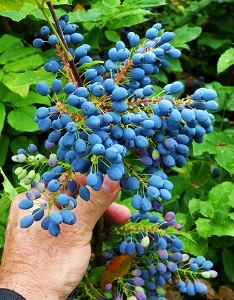 unwanted pedestrian traffic. The blush blue berries are ready for picking from late summer to early fall – these are quite tart for fresh eating. That said, they make superb preserves as the tangy concord grape/wild blueberry flavour of Oregon Grape jelly is unlike anything you can purchase in a store. I made my own this year using the recipe from http://www.backwoodshome.com, although I did add the juice of half a lemon which was not called for. The result turned out to be a family favourite and one which people came back for time and again during my samplings at garden clubs. Just be sure not to strip the bushes of berries when harvesting, as these are readily plundered as a
unwanted pedestrian traffic. The blush blue berries are ready for picking from late summer to early fall – these are quite tart for fresh eating. That said, they make superb preserves as the tangy concord grape/wild blueberry flavour of Oregon Grape jelly is unlike anything you can purchase in a store. I made my own this year using the recipe from http://www.backwoodshome.com, although I did add the juice of half a lemon which was not called for. The result turned out to be a family favourite and one which people came back for time and again during my samplings at garden clubs. Just be sure not to strip the bushes of berries when harvesting, as these are readily plundered as a 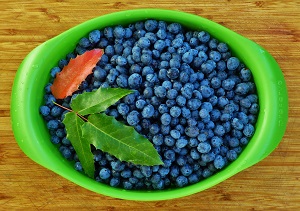 food staple by the likes of robins and thrushes. After harvest, Tall Oregon Grape undergoes a transformation from green to a burgundy-red as the frosts make their appearance, and this foliage colour remains throughout the winter until the spring flush. Longleaf Oregon Grape (Mahonia nervosa) undergoes an even more spectacular transformation, shifting from a dull green to a rich wine red hue in the colder weather. This is a lower growing species (averaging 18-24″ tall) that colonizes to form a tall groundcover useful for shaded areas under those unforgiving Western Red Cedars. This species also has longer leaflets but with the typical yellow terminal blooms followed by edible blue berries. Mahonia repens is another groundcover species that is found a little further afield than just the Pacific Northwest, ranging through the Rocky Mountains and southwards to Arizona
food staple by the likes of robins and thrushes. After harvest, Tall Oregon Grape undergoes a transformation from green to a burgundy-red as the frosts make their appearance, and this foliage colour remains throughout the winter until the spring flush. Longleaf Oregon Grape (Mahonia nervosa) undergoes an even more spectacular transformation, shifting from a dull green to a rich wine red hue in the colder weather. This is a lower growing species (averaging 18-24″ tall) that colonizes to form a tall groundcover useful for shaded areas under those unforgiving Western Red Cedars. This species also has longer leaflets but with the typical yellow terminal blooms followed by edible blue berries. Mahonia repens is another groundcover species that is found a little further afield than just the Pacific Northwest, ranging through the Rocky Mountains and southwards to Arizona 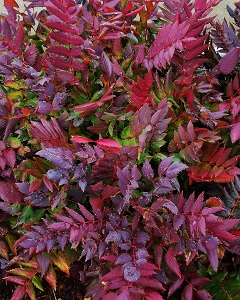 and New Mexico. It generally grows 12″ or less in height and the bright yellow inner bark was used by indigenous peoples as a source of dye. The blush blue berries are also edible but not always produced as plentifully as the previously mentioned species. All of these Oregon Grapes tolerate full sun (with protection from winter winds) to part shade and will grow in deep shade, but with less vigor and little fruit. Dwarf forms of Mahonia aquifolium such as ‘Compacta’ (grows to 3′ tall) are also available if the standard height of 6′ is a little much for your needs. All of the species mentioned are hardy to USDA zone 5, although some winter shelter would be prudent in colder regions.
and New Mexico. It generally grows 12″ or less in height and the bright yellow inner bark was used by indigenous peoples as a source of dye. The blush blue berries are also edible but not always produced as plentifully as the previously mentioned species. All of these Oregon Grapes tolerate full sun (with protection from winter winds) to part shade and will grow in deep shade, but with less vigor and little fruit. Dwarf forms of Mahonia aquifolium such as ‘Compacta’ (grows to 3′ tall) are also available if the standard height of 6′ is a little much for your needs. All of the species mentioned are hardy to USDA zone 5, although some winter shelter would be prudent in colder regions.
Crabapples…The Perfect Fruit
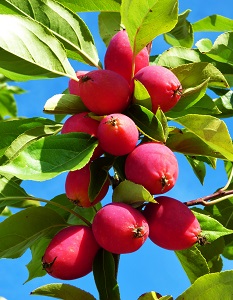 Novice gardeners always seem to have a difficult time choosing fruit trees and I can’t blame them. There is so much conflicting information out there about which ones are the easiest to grow, the most productive or disease resistant. Truth be told, it depends on where you live and since many of us are getting our advice online, it can literally come from anywhere…including California, Australia or the UK, which is fine if you live in California, Australia or the UK. But for those of us that reside in Canada we can fall desperately short on those
Novice gardeners always seem to have a difficult time choosing fruit trees and I can’t blame them. There is so much conflicting information out there about which ones are the easiest to grow, the most productive or disease resistant. Truth be told, it depends on where you live and since many of us are getting our advice online, it can literally come from anywhere…including California, Australia or the UK, which is fine if you live in California, Australia or the UK. But for those of us that reside in Canada we can fall desperately short on those 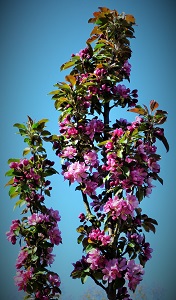 long summers, mild winter temperatures and available pollinators. So if I could recommend one fruit tree that will be successful regardless of where you live in this country (except for the extreme north) it would be the crabapple. First off, they are generally self-fertile (the exception being apple-crab hybrids like ‘Kerr’) so you won’t need to purchase another tree for cross-pollination and fruit production. Crabapples are often grafted on semi-dwarf
long summers, mild winter temperatures and available pollinators. So if I could recommend one fruit tree that will be successful regardless of where you live in this country (except for the extreme north) it would be the crabapple. First off, they are generally self-fertile (the exception being apple-crab hybrids like ‘Kerr’) so you won’t need to purchase another tree for cross-pollination and fruit production. Crabapples are often grafted on semi-dwarf 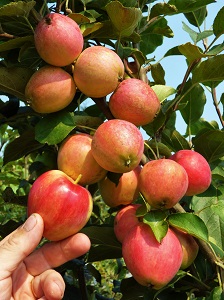 rootstock such as M26, which would make the mature tree around the 10 to 12′ range – this is important because it won’t take a lot of room in your new garden and other options such as the recently introduced columnar forms EMERALD SPIRE and PURPLE SPIRE are also available. The cold hardiness is generally USDA zone 3 (with some gardeners having success in zone 2) which means that it can be grown from coast to coast, including the prairies. Crabapples come into bearing at a young age, so that you don’t have to wait years for your crops to arrive. The flowers are spectacular, ranging in colour from creamy-white to pink and even deep magenta – easily passing as an ornamental tree when in
rootstock such as M26, which would make the mature tree around the 10 to 12′ range – this is important because it won’t take a lot of room in your new garden and other options such as the recently introduced columnar forms EMERALD SPIRE and PURPLE SPIRE are also available. The cold hardiness is generally USDA zone 3 (with some gardeners having success in zone 2) which means that it can be grown from coast to coast, including the prairies. Crabapples come into bearing at a young age, so that you don’t have to wait years for your crops to arrive. The flowers are spectacular, ranging in colour from creamy-white to pink and even deep magenta – easily passing as an ornamental tree when in 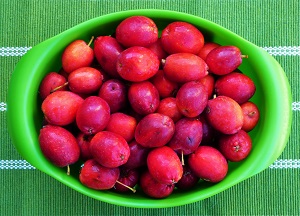 bloom. They are generally disease-free, although you might see a bit of scab if you have a wet spring. The fruit, which is small but abundant, has many uses including fresh eating (with its refreshing, tart flavour),
bloom. They are generally disease-free, although you might see a bit of scab if you have a wet spring. The fruit, which is small but abundant, has many uses including fresh eating (with its refreshing, tart flavour), 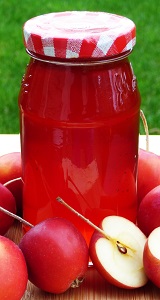 blending in homemade juices or apple ciders, canning them whole as spiced crabapples (I can still taste my grandmother’s clove-infused version) and best of all, creating one of the most delicious jellies for your morning toast. ‘Dolgo’ is probably your best bet for the latter as it makes a beautiful ruby-red jelly and usually requires no pectin due to its naturally high content. It is also one of the easiest cultivars to find at your local garden centre, although ‘Chestnut’ and ‘Whitney’ can also be sourced and have larger rounded fruits. So if you are looking for an anchor for your new edible garden, one that is aesthetically beautiful and equally productive, then consider the humble crabapple.
blending in homemade juices or apple ciders, canning them whole as spiced crabapples (I can still taste my grandmother’s clove-infused version) and best of all, creating one of the most delicious jellies for your morning toast. ‘Dolgo’ is probably your best bet for the latter as it makes a beautiful ruby-red jelly and usually requires no pectin due to its naturally high content. It is also one of the easiest cultivars to find at your local garden centre, although ‘Chestnut’ and ‘Whitney’ can also be sourced and have larger rounded fruits. So if you are looking for an anchor for your new edible garden, one that is aesthetically beautiful and equally productive, then consider the humble crabapple.

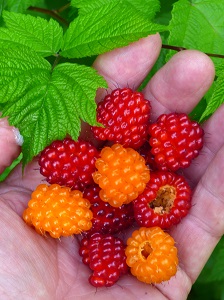 Salmonberries are one of the most overlooked wild edibles on the west coast, perhaps because of their undeserved reputation for being somewhat bland. While these large suckering shrubs will vary in fruit quality from clone to clone, I can honestly say that I have never tasted a drab salmonberry. The species is native from California up to Alaska and is hardy to USDA zone 5 – so with the exception of a few pockets
Salmonberries are one of the most overlooked wild edibles on the west coast, perhaps because of their undeserved reputation for being somewhat bland. While these large suckering shrubs will vary in fruit quality from clone to clone, I can honestly say that I have never tasted a drab salmonberry. The species is native from California up to Alaska and is hardy to USDA zone 5 – so with the exception of a few pockets 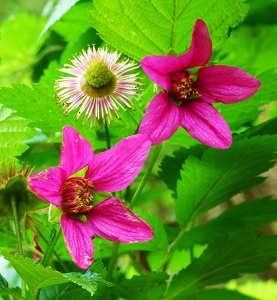 in northern Idaho, it is generally found along the coast in the temperate rainforest. Here in British Columbia it commonly seen in areas with moist soils, such as adjacent to streams and wetlands. Rubus spectabilis flowers in early spring and the bright magenta-pink blossoms are much favoured by the overwintering Anna’s hummingbirds and seem to coincide
in northern Idaho, it is generally found along the coast in the temperate rainforest. Here in British Columbia it commonly seen in areas with moist soils, such as adjacent to streams and wetlands. Rubus spectabilis flowers in early spring and the bright magenta-pink blossoms are much favoured by the overwintering Anna’s hummingbirds and seem to coincide 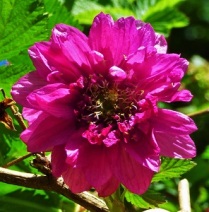 with the return of the migrating Rufous. There is a large double-flowered form called ‘Olympic Double’ or ‘Flore Pleno’ which is primarily ornamental in nature, as the fruit production is rather poor. This was an important food species for many indigenous peoples and the early-ripening berries (May-June) were often
with the return of the migrating Rufous. There is a large double-flowered form called ‘Olympic Double’ or ‘Flore Pleno’ which is primarily ornamental in nature, as the fruit production is rather poor. This was an important food species for many indigenous peoples and the early-ripening berries (May-June) were often  picked from family-owned patches by the Coast Salish, with these areas open to others after the main harvest. The berries were generally eaten fresh (due to their high water content and difficulty to preserve) with smoked salmon. Having just read Eden Robinson’s novel Monkey Beach about the Haisla, I also learned that the
picked from family-owned patches by the Coast Salish, with these areas open to others after the main harvest. The berries were generally eaten fresh (due to their high water content and difficulty to preserve) with smoked salmon. Having just read Eden Robinson’s novel Monkey Beach about the Haisla, I also learned that the 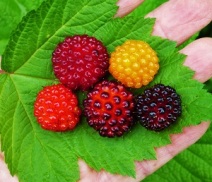 young stems were harvested as a vegetable and either peeled and eaten raw, or steamed. The fruit gets its name from its resemblance to salmon roe, and I know of a few fisherman who still use salmonberries as bait. Ripe berries can vary in colour from red to orange, yellow and dark purple, with some people preferring the flavour of the darker berries – as for myself, I find the
young stems were harvested as a vegetable and either peeled and eaten raw, or steamed. The fruit gets its name from its resemblance to salmon roe, and I know of a few fisherman who still use salmonberries as bait. Ripe berries can vary in colour from red to orange, yellow and dark purple, with some people preferring the flavour of the darker berries – as for myself, I find the 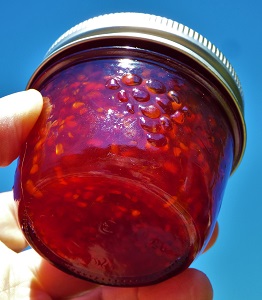 yellow ones just as tasty. However if you are a little late picking them, you will quickly notice the birds preference for the darker fruit, as the golden ones are often left to rot on the bush. Rubus spectabilis can be a difficult fit for urban landscapes due to its thorns, suckering nature and sprawling habit. That being said, it is an excellent candidate for riparian rejuvenation as it controls erosion well and competes with the
yellow ones just as tasty. However if you are a little late picking them, you will quickly notice the birds preference for the darker fruit, as the golden ones are often left to rot on the bush. Rubus spectabilis can be a difficult fit for urban landscapes due to its thorns, suckering nature and sprawling habit. That being said, it is an excellent candidate for riparian rejuvenation as it controls erosion well and competes with the 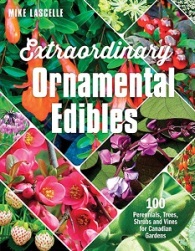 often overbearing Himalayan blackberry which is quickly overwhelming our forests. Salmonberry is a deciduous shrub that prefers a part to full sun exposure, but will tolerate open shade, and it is completely self-fertile. The berries make a delicious jam or wine, and they are easy to freeze for later use. If you would like to learn more about edible native berries, look for my new book Extraordinary Ornamental Edibles by Douglas & McIntyre.
often overbearing Himalayan blackberry which is quickly overwhelming our forests. Salmonberry is a deciduous shrub that prefers a part to full sun exposure, but will tolerate open shade, and it is completely self-fertile. The berries make a delicious jam or wine, and they are easy to freeze for later use. If you would like to learn more about edible native berries, look for my new book Extraordinary Ornamental Edibles by Douglas & McIntyre.

